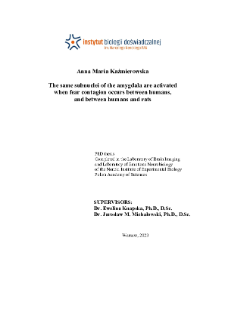- Search in all Repository
- Literature and maps
- Archeology
- Mills database
- Natural sciences
Advanced search
Advanced search
Advanced search
Advanced search
Advanced search

Object
Title: The same subnuclei of the amygdala are activated when fear contagion occurs between humans and between humans and rats : PhD thesis
Institutional creator:
Instytut Biologii Doświadczalnej im. Marcelego Nenckiego PAN
Contributor:
Knapska, Ewelina (1977- ) : Supervisor ; Michałowski, Jarosław M. : Supervisor
Publisher:
Nencki Institute of Experimental Biology PAS
Place of publishing:
Description:
80 pages : illustrations ; 30 cm ; Bibliography ; Summary in Polish
Degree name:
Degree discipline :
Degree grantor:
Nencki Institute of Experimental Biology PAS ; degree obtained: 23.06.2023
Type of object:
Abstract:
Fear contagion is an automatic process of aligning one animal's emotional state with another's emotional distress. It has been described in different social species, including rats and humans. Reading the emotional states of others has recently been suggested to play an essential role in detecting danger. If so, one could expect fear contagion to be a cross-species phenomenon. However, this hypothesis has yet to be tested. Both rat and human studies implicated the amygdala, a brain structure crucial for processing emotions, in fear contagion.Further, the rat studies showed that two main parts of the amygdala, which differ morphologically and functionally - the basolateral and centromedial nuclei - are involved in emotional transfer. Such a detailed analysis of the amygdala activity has yet to be performed for human-human emotional transfer. In this doctoral thesis, I aimed to test whether the cross- species (human-rat) fear transfer occurs and whether it involves the basolateral and centromedial parts of the amygdala (study 1). Their involvement was also verified during the human-human fear contagion (study 2).In study 1, the habituated rats were handled by familiar humans who underwent the fear conditioning task (or an emotionally neutral task in the control condition). Following the interaction, the rats' amygdala activations were analyzed using the expression of c-Fos, a marker of neuronal activation. I observed that the rat amygdala was activated to a greater extent in the experimental rats compared to the control rats. That was true for both the basolateral and centromedial divisions. The behavioral differences between the experimental and control rats further confirmed the successful transfer of fear from human to rat.Study 2 was performed using functional magnetic resonance imaging (fMRI). Participants (so-called observers) were placed in the fMRI scanner and watched their friends (so-called demonstrators) undergoing the classical fear conditioning paradigm. In this task, a neutral stimulus was repeatedly paired with aversive electrical stimulation applied to the forearm. I analyzed the observers' brain responses to the electric shocks administered to their friends and found enhanced activations in the amygdala. Also, here, both the basolateral and centromedial divisions were activated.The thesis provides the first neural evidence for interspecies fear contagion. The findings indicate that both main divisions of the amygdala respond when human fear is transmitted to another human and a rat. This suggests a common brain circuit involved in perceiving fear socially in humans and rats. I argue that it could have evolved to enable sharing of the emotional cues essential for survival across species
Detailed Resource Type:
Resource Identifier:
Source:
Language:
Language of abstract:
Rights:
Terms of use:
Copyright-protected material. May be used within the limits of statutory user freedoms
Copyright holder:
Publication made available with the written permission of the author
Digitizing institution:
Nencki Institute of Experimental Biology of the Polish Academy of Sciences
Original in:
Library of the Nencki Institute of Experimental Biology PAS
Access:
Object collections:
- Digital Repository of Scientific Institutes > Partners' collections > Nencki Institute of Experimental Biology PAS
- Digital Repository of Scientific Institutes > Partners' collections > Nencki Institute of Experimental Biology PAS > Dissertations
- Digital Repository of Scientific Institutes > Partners' collections > Nencki Institute of Experimental Biology PAS > Dissertations > PhD Thesis
- Digital Repository of Scientific Institutes > Literature
- Digital Repository of Scientific Institutes > Literature > Thesis
Last modified:
Dec 13, 2024
In our library since:
Jul 20, 2023
Number of object content downloads / hits:
126
All available object's versions:
https://rcin.org.pl./publication/275533
Show description in RDF format:
Show description in RDFa format:
Show description in OAI-PMH format:
Objects Similar
Dzięgiel-Fivet, Gabriela
Beck, Joanna
Kulesza, Maria
Nowicka, Klaudia
Tomaszewski, Kamil Filip
Przetwarzanie informacji o nagrodach naturalnych i farmakologicznych w mózgu myszy : praca doktorska
Bijoch, Łukasz
Poks, Małgorzata
Szabat, Marta

 INSTYTUT ARCHEOLOGII I ETNOLOGII POLSKIEJ AKADEMII NAUK
INSTYTUT ARCHEOLOGII I ETNOLOGII POLSKIEJ AKADEMII NAUK
 INSTYTUT BADAŃ LITERACKICH POLSKIEJ AKADEMII NAUK
INSTYTUT BADAŃ LITERACKICH POLSKIEJ AKADEMII NAUK
 INSTYTUT BADAWCZY LEŚNICTWA
INSTYTUT BADAWCZY LEŚNICTWA
 INSTYTUT BIOLOGII DOŚWIADCZALNEJ IM. MARCELEGO NENCKIEGO POLSKIEJ AKADEMII NAUK
INSTYTUT BIOLOGII DOŚWIADCZALNEJ IM. MARCELEGO NENCKIEGO POLSKIEJ AKADEMII NAUK
 INSTYTUT BIOLOGII SSAKÓW POLSKIEJ AKADEMII NAUK
INSTYTUT BIOLOGII SSAKÓW POLSKIEJ AKADEMII NAUK
 INSTYTUT CHEMII FIZYCZNEJ PAN
INSTYTUT CHEMII FIZYCZNEJ PAN
 INSTYTUT CHEMII ORGANICZNEJ PAN
INSTYTUT CHEMII ORGANICZNEJ PAN
 INSTYTUT FILOZOFII I SOCJOLOGII PAN
INSTYTUT FILOZOFII I SOCJOLOGII PAN
 INSTYTUT GEOGRAFII I PRZESTRZENNEGO ZAGOSPODAROWANIA PAN
INSTYTUT GEOGRAFII I PRZESTRZENNEGO ZAGOSPODAROWANIA PAN
 INSTYTUT HISTORII im. TADEUSZA MANTEUFFLA POLSKIEJ AKADEMII NAUK
INSTYTUT HISTORII im. TADEUSZA MANTEUFFLA POLSKIEJ AKADEMII NAUK
 INSTYTUT JĘZYKA POLSKIEGO POLSKIEJ AKADEMII NAUK
INSTYTUT JĘZYKA POLSKIEGO POLSKIEJ AKADEMII NAUK
 INSTYTUT MATEMATYCZNY PAN
INSTYTUT MATEMATYCZNY PAN
 INSTYTUT MEDYCYNY DOŚWIADCZALNEJ I KLINICZNEJ IM.MIROSŁAWA MOSSAKOWSKIEGO POLSKIEJ AKADEMII NAUK
INSTYTUT MEDYCYNY DOŚWIADCZALNEJ I KLINICZNEJ IM.MIROSŁAWA MOSSAKOWSKIEGO POLSKIEJ AKADEMII NAUK
 INSTYTUT PODSTAWOWYCH PROBLEMÓW TECHNIKI PAN
INSTYTUT PODSTAWOWYCH PROBLEMÓW TECHNIKI PAN
 INSTYTUT SLAWISTYKI PAN
INSTYTUT SLAWISTYKI PAN
 SIEĆ BADAWCZA ŁUKASIEWICZ - INSTYTUT TECHNOLOGII MATERIAŁÓW ELEKTRONICZNYCH
SIEĆ BADAWCZA ŁUKASIEWICZ - INSTYTUT TECHNOLOGII MATERIAŁÓW ELEKTRONICZNYCH
 MUZEUM I INSTYTUT ZOOLOGII POLSKIEJ AKADEMII NAUK
MUZEUM I INSTYTUT ZOOLOGII POLSKIEJ AKADEMII NAUK
 INSTYTUT BADAŃ SYSTEMOWYCH PAN
INSTYTUT BADAŃ SYSTEMOWYCH PAN
 INSTYTUT BOTANIKI IM. WŁADYSŁAWA SZAFERA POLSKIEJ AKADEMII NAUK
INSTYTUT BOTANIKI IM. WŁADYSŁAWA SZAFERA POLSKIEJ AKADEMII NAUK




































